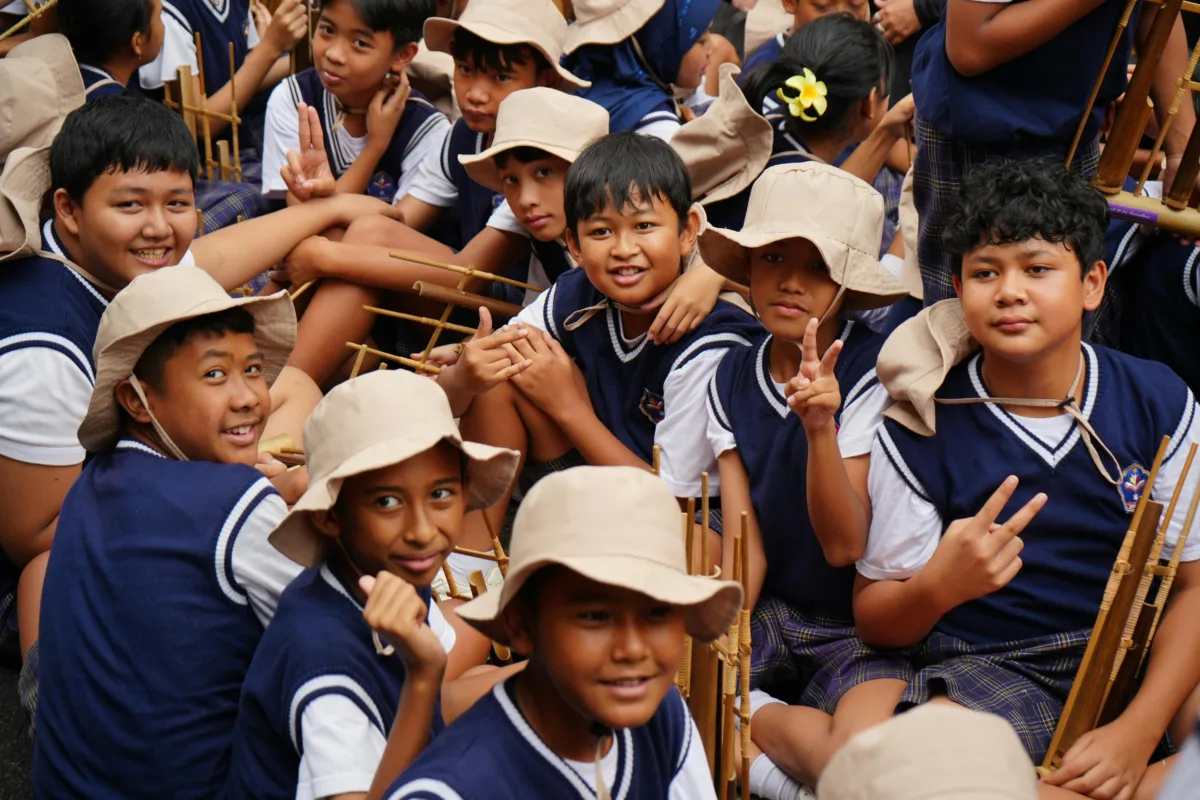
Tanda Tangan Online: Sign Smarter, Not Harder
July 20, 2025
Is Super.com Legit? What You Need to Know Before You Book
July 21, 2025Angklung Berasal Dari Questions?
Updated: July 2025
Have you ever seen a group of people shaking bamboo tubes and somehow creating beautiful, harmonious music? That’s angklung. It’s more than just a traditional Indonesian instrument – it’s a symbol of unity, heritage, and rhythm, all rolled into one.
Now, if you’re here wondering angklung berasal dari mana, you’re not alone. It’s one of the most Googled phrases about this instrument, and the answer isn’t just “Indonesia.” There’s a rich backstory that connects angklung to Jawa Barat, Sundanese culture, ancient rituals, and even modern-day music stages across the globe.
So, let’s shake things up (literally) and dive into 10 fascinating things you probably didn’t know about angklung – including where it comes from, how to play it, and why the whole world is falling in love with this charming bamboo ensemble.
Angklung Berasal dari Mana, Sih?
Let’s start with the big question that brought you here: angklung berasal dari mana? The answer is simple on the surface angklung berasal dari Jawa Barat or West Java. But if we dig just a little deeper, we’ll find that this instrument carries more than just geographical roots; it holds centuries of cultural meaning, spiritual purpose, and community pride.
Angklung originated from the Sundanese people, one of Indonesia’s major ethnic groups. In Sundanese villages, music wasn’t just for entertainment. It was a vital part of life, used to communicate with the natural world and seek harmony with unseen forces. The angklung, with its earthy bamboo tones, was believed to have the power to call the spirits of fertility, bless the rice fields, and bring rainfall during times of drought.
Fun Fact
In fact, one of the earliest uses of the angklung was in seren taun a traditional harvest ceremony where entire communities gathered to express gratitude for a good season and pray for future abundance. Villagers would shake the angklung in rhythm, creating a unified sound that symbolized togetherness and hope. Back then, each angklung was tuned to specific ceremonial pitches, and only the village elders or spiritual leaders were allowed to play them.
As time went on, the angklung’s role evolved. It began appearing in more festive settings like weddings, local performances, and eventually classrooms. No longer confined to ritual, angklung became a tool for education, culture-sharing, and performance. Its popularity spread across Java, then to other Indonesian islands, and now far beyond.
Today, angklung is part of national school curricula in Indonesia. Students across the country learn how to play it, not just as a musical skill, but as a way to connect with their heritage. It’s also been performed in international arenas – from the United Nations Headquarters to cultural festivals in Europe and Asia.
In 2010, angklung received international recognition when UNESCO declared it part of the Intangible Cultural Heritage of Humanity, a huge milestone that secured its preservation and global appreciation.
So yes, alat musik angklung berasal dari West Java. But its story doesn’t stop there. It started in Sundanese soil, but today, it echoes on global stages all thanks to the timeless magic of bamboo and the people who never stopped playing it.

Why Is Angklung Made of Bamboo?
There’s a good reason angklung isn’t made of plastic, metal, or any modern material — bamboo is intentional. This natural material is lightweight, strong, and flexible, which makes it ideal for crafting tuned sound tubes.
Each angklung consists of two or more bamboo tubes that are carved and tuned to resonate at specific pitches. The tubes are then mounted in a wooden frame that allows them to shake freely. When you rattle the frame, the tubes vibrate and create that unique, bright sound angklung is famous for.
Beyond the practical side, bamboo also holds spiritual significance in many Indonesian cultures. It symbolizes resilience, harmony, and connection to nature all values deeply embedded in Sundanese tradition.
How Does the Angklung Actually Work?
At first glance, the angklung looks like a bunch of bamboo tubes tied together with string. But don’t let its humble appearance fool you this instrument is an absolute marvel of sound engineering and community spirit.
Here’s the fun twist: each angklung only produces a single pitch. That’s right just one. So if you were hoping to play a solo concert with just one angklung, you’d be stuck shaking the same note until the end of time. That’s why angklung is inherently a team instrument. To perform a melody, multiple players are needed, each assigned a specific tone. When these notes are played in perfect rhythm, they form a complete song like magic.
Imagine a human piano where every person is one key. One player shakes their angklung for a C note, another for a D, another for an E, and so on. The result is a rich, flowing melody that depends entirely on coordination and timing. Miss your cue, and the harmony falls apart but when everyone hits their part, the sound is beautifully mesmerizing.
The method of playing it
This method of playing makes angklung not just a musical activity, but a social one. It demands listening, focus, and most of all, collaboration. In fact, that’s part of why alat musik angklung berasal dari such a strong cultural value: togetherness.
The instrument wasn’t designed for solo stardom. It was built for villages, for classrooms, for communities – where everyone has a role to play, and harmony only exists when we all shake in sync. It’s music with a message: unity, rhythm, and respect. And it’s one of the few instruments in the world that literally teaches cooperation with every performance.
So the next time you see an angklung ensemble performing in perfect unison, know that behind each note is a carefully timed team effort – and a reminder that music, like life, sounds best when we work together.
Cara Memainkan Angklung (Even If You’re Not Musical)
You don’t need to be a musician to learn cara memainkan angklung. That’s part of its charm. Most people start by holding the angklung in one hand while shaking it with the other. The key is timing. Since each angklung plays just one note, you have to wait for your turn — and play it exactly when it’s needed.
Many Indonesian schools teach angklung to children as part of their music and culture curriculum. It helps students learn discipline, collaboration, and listening skills. Plus, it’s fun — there’s something satisfying about being one note in a larger, beautiful sound.
There are even professional angklung ensembles that play pop songs, movie themes, and traditional folk music using nothing but angklung.
Why Has the World Fallen in Love with Angklung?
What started in West Java has now gone global. Angklung performances have taken place in the United Nations, music festivals in Europe, and international schools around the world.
In 2010, angklung was officially recognized by UNESCO as a Masterpiece of the Oral and Intangible Heritage of Humanity. That recognition helped elevate angklung’s profile and encouraged more preservation efforts, both within Indonesia and abroad.
In fact, angklung once set a Guinness World Record when thousands of people played it simultaneously in Washington D.C. during a cultural event. That’s right angklung is no longer just traditional. It’s international.
What Does an Angklung Look Like? (Let’s Visualize It)
Let’s talk design. A typical gambar angklung shows two to four bamboo tubes hanging from a carved frame. The tubes are different lengths, each tuned to a specific pitch. Some angklung instruments are very small and high-pitched, while others are large and deep.
The frame is usually made of hardwood and may include decorative elements like batik cloth, traditional carvings, or the group’s insignia. Modern angklung designs sometimes include color-coded markings to help players identify their notes quickly especially helpful in schools.
So if you’ve never seen an angklung in person, picture a set of bamboo chimes… but playable, precise, and far more powerful.
From Tradition to TikTok: Angklung in Pop Culture
Still think angklung is just for ceremonies or sleepy school assemblies? Not anymore. In today’s digital age, this humble bamboo instrument is having a major glow-up and yes, it’s going viral.
Thanks to platforms like TikTok, Instagram, and YouTube, angklung has stepped into the spotlight with fresh energy. Musicians, content creators, and even student clubs are producing impressive angklung renditions of pop hits from Coldplay ballads and BTS anthems to trending Disney soundtracks. And we’re not just talking about basic versions. These covers often feature tight choreography, LED lighting, matching outfits, and full-on stage production.
What’s cooler? Some of these clips rack up thousands (even millions) of views, introducing global audiences to an instrument many have never seen or heard before. It’s angklung meets algorithm and the algorithm seems to love it.
But the rise of angklung in pop culture doesn’t stop there. All over Indonesia and beyond, angklung competitions are drawing huge crowds. Teams of players sometimes with dozens or even hundreds of instruments — take the stage in perfectly timed performances. Judges look for coordination, musicality, and creative arrangements. It’s like a battle of the bands, but instead of guitars and drums, you’ve got bamboo, heart, and harmony.
This evolution of angklung proves something powerful: alat musik angklung berasal dari masyarakat, and the people are still shaping how it lives today. From traditional ceremonies to trending reels, angklung continues to connect generations reminding us that heritage doesn’t have to stay in the past. Sometimes, it dances right into your For You Page.
Alat Musik Angklung Berasal dari Daerah Mana?
Let’s go even deeper. While angklung is widely known across Indonesia today, alat musik angklung berasal dari daerah Jawa Barat, specifically from Sundanese villages where it was more than entertainment it was a spiritual tool.
The sound of angklung was believed to align with nature’s energy. It was used during seren taun (harvest festivals), performed in the fields to call for rain or ward off misfortune. Today, this ritualistic connection may not be as common, but the sense of community and tradition remains strong.
Even modern players, whether in Bandung or Berlin, are unknowingly continuing that legacy every time they perform.
Can You Build Your Own Angklung?
Yes, you can! While professional angklung instruments are handcrafted by skilled artisans, there are DIY versions you can create using simple materials like PVC pipes, plastic tubing, or even chopsticks.
Some educational kits allow students to build their own mini angklung, helping them understand sound waves, pitch, and resonance in a hands-on way. Teachers love using these in music and science lessons because they blend culture, creativity, and physics in one fun project.
So if you’re feeling crafty, try building a basic one at home – and yes, you’ll definitely appreciate real angklung craftsmanship even more afterward.
Final Vibes: More Than Just Bamboo Tubes
So now you know – angklung berasal dari Jawa Barat, but its sound has traveled far beyond rice fields and village ceremonies. From traditional harvest festivals to viral TikTok covers, angklung continues to evolve while staying true to its roots.
It’s not just alat musik Jawa Barat, and it’s more than just a classroom project. It’s a living symbol of unity, collaboration, and cultural pride. Whether you’re curious about cara memainkan angklung, wondering about its spiritual origins, or just came for gambar angklung and stayed for the music, one thing’s for sure: this instrument is here to stay.
So go ahead shake a little, learn a little, and let the rhythm of angklung remind you that music doesn’t just sound good… it brings people together.
FAQ – Everything You Still Wonder About Angklung
Q: Where does the angklung come from?
A: Angklung berasal dari West Java, specifically from the Sundanese people. It was originally used in traditional ceremonies and community events.
Q: What kind of instrument is an angklung?
A: The angklung is a traditional Indonesian musical instrument made of bamboo. It’s shaken to produce sound, with each one playing a single note.
Q: Is the angklung still used today?
A: Yes! It’s used in schools, performed at cultural festivals, and even featured in modern content on platforms like TikTok and YouTube.
Q: How do you play the angklung?
A: You hold the bamboo frame and gently shake it side to side. Since each angklung only produces one pitch, it’s usually played in groups to form full melodies.
Q: Why is angklung considered an important traditional instrument?
A: Because it reflects harmony, teamwork, and cultural identity. Plus, it’s recognized by UNESCO as an Intangible Cultural Heritage.
Q: Are there any angklung visuals or diagrams for students?
A: Yes, just search for “gambar angklung” and you’ll find illustrations and diagrams commonly used in schools and learning materials.
Q: Does angklung only come from West Java?
A: While alat musik angklung berasal dari West Java, its influence has spread across Indonesia and even gained international attention.
Q: Can you use angklung to play modern songs?
A: Absolutely. Many groups now perform pop, classical, and even EDM covers using angklung, showing its versatility beyond traditional music.




